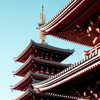
A cultural guide to Tokyo
By Ashley Ogawa Clarke
August 2023
From ancient temples to the futuristic Tokyo Skytree, past and present live side by side in Japan’s mesmerizing capital city
Your essential guide to the best things to see and do in Tokyo. Find more travel inspiration for more amazing cities here.
Tokyo is a city of layers. From its fashionable underground malls to hidden izakayas (informal bars), tranquil ancient temples to futuristic sky bars that look out over the glittering metropolis below, the world’s most populous city is a dizzying dichotomy of old and new.

Join locals at an izakaya, an informal bar
Tokyo’s history began as a humble fishing village that was later crowned the new imperial capital during the Meiji Restoration of 1868. After suffering a catastrophic earthquake in 1923 and being bombed extensively in World War II, the metropolis today is an anachronistic mix of glassy skyscrapers, inner-city temples, and an impressive public railway system.
With some 39 million people living in Greater Tokyo, the city may seem overwhelming at first glance, but travelers who embrace the capital’s dynamic energy will be rewarded by its unique cuisine, incredible shopping, and welcoming locals—omotenashi is the Japanese term for hospitality, and you’ll find it in spades in Tokyo.

Japan’s best-kept-secret beaches
As well as its hyper-modern cities, Japan is home to beautiful but unsung beaches
Art & architecture
The city’s most notable art galleries and museums are concentrated largely in Ueno, a relaxed district where you can spend a day gallery hopping between Tokyo National Museum, Tokyo Metropolitan Art Museum, and plenty of other history and art destinations. The Grutto Pass will get you discounts (and occasionally free access) to 103 museums and facilities around the city, most of which are open from around 10 a.m.–5 p.m. all week.
Alternatively, take a stroll through stylish Aoyama to the peaceful Nezu Museum, a traditional Japanese gallery flanked by walls of bamboo forest and with a secret garden, restored by renowned architect Kengo Kuma.

The five-story pagoda beside Sensō-ji, Tokyo’s oldest shrine
Cherry blossom lining the Meguro River
Feel the surviving spirit of old-world Tokyo by booking a walking tour through historical Yanaka, or take a (remarkably free) guided tour of the Imperial Palace, home to Japan’s royal family, which runs from Tuesdays through Saturdays.
For something more futuristic, let your jaw drop at teamLab Planets, an immersive digital experience in Tokyo Bay where you can lie down in a universe of falling flowers or paddle among projections of rainbow-colored fish. Alternatively, walk under the towering arachnid Maman sculpture in glitzy Roppongi Hills on your way to the Mori Art Museum, with its spectacular 52nd-floor observatory.
Expert tips
The essentials
The local currency is the Japanese yen (JPY). Tipping is not customary in Japan. Instead, express gratitude with a polite bow or a simple arigato gozaimasu (thank you very much). Japanese is the official language, and English proficiency can be limited. Carry a phrasebook or use translation apps for basic communication.
Fly to Tokyo Haneda Airport (HND) or Narita International Airport (NRT); the latter is about 50 miles from the city center but offers more international flights. Take the Narita Express (one hour) or Keisei Skyliner train (45 mins) from Narita, or the Tokyo Monorail from Haneda Airport (around 20 mins) to reach downtown Tokyo. A rideshare from Haneda Airport takes around one hour to reach downtown Tokyo.
Getting around
Tokyo’s extensive subway and train system is the best way to get around. Consider purchasing a Suica or PASMO card for easy payment. Taxis are widely available but can be expensive. Utilize ride-sharing apps or book through a hotel or taxi stand. Ask the hotel concierge to write your destination in Japanese. Renting a bicycle is a great way to explore smaller neighborhoods and parks. Look for bike-sharing services or bike rental shops. Experience a scenic boat ride along the Sumida River or rent a traditional rowboat in Ueno Park for a unique view of Tokyo.
Accessibility
Tokyo’s public transportation system is generally accessible, although the morning rush hour is best avoided due to crowding. Wheelchair ramps, elevators and accessible restrooms are available in major stations, and trains have priority seating. There are tactile paving strips throughout the city as well as audible signals at most pedestrian crossings to support mobility. Check with individual museums and landmarks for special accommodations, such as audio guides and tactile exhibits for the visually impaired.
LGBTQ+
Tokyo has a vibrant LGBTQ+ scene, with particularly good nightlife and events held around the Shinjuku and Shibuya neighborhoods. Visit Ni-chome in Shinjuku, known as Tokyo’s LGBTQ+ district, with a variety of bars, clubs, and LGBTQ+ friendly establishments. Tokyo Rainbow Pride is held in April, featuring a colorful parade and festivities across the Harajuku and Shibuya areas.
Food & drink
Eating alone in Tokyo is normalized thanks to the frenetic working culture, and there are thousands of restaurants that serve everything from ¥400 (less than $3) udon noodles to high-end sushi to Michelin-starred ramen and indulgent tempura.
Head to Tonki, celebrated for its tonkatsu (breaded pork cutlet), or sit down to a picture-worthy parfait at Coffee Seibu, one of Japan’s must-visit kissaten (old-fashioned cafés). For a truly local experience, join the crowds of salarymen and grab a late-night bite and a pint of Sapporo beer at one of the bustling alleyway eateries in Ebisu Yokocho.
Narukiyo, with its in-house DJ and indecipherable, scroll-like menu, is the hottest omakase restaurant in town (the literal translation is “chef’s choice”); the fresh seafood and seasonal vegetables give an authentic taste of the city in a setting that feels traditional yet contemporary.
Watch before you go
Made famous by the 2003 film Lost in Translation, the sleek New York Grill & Bar on the 52nd floor of the Park Hyatt Tokyo in Nishi-Shinjuku (closed for refurbishment until October 2025) is still worth a visit for its unbeatable views of the city. Afternoon tea or cocktails in the Peak Lounge & Bar—the bamboo sky garden on the 41st floor—offer an equally atmospheric experience.
Home to the iconic scramble crossing, this central district is one of the city’s busiest and buzziest. It’s also where you’ll find Harajuku, one of Tokyo’s key fashion neighborhoods. Explore the Laforet department store there to find the most vibrant selection of independent fashion in the city. Shibuya is also home to the PARCO department store, a 10-floor behemoth with everything from high-end fashion to a Pokémon Center (grab a Pikachu plushie or five).
The sophisticated shopping district of Ginza offers the best department stores the city has to offer—from the century-old Mitsukoshi to the sleek Ginza Six. Just a short taxi ride away, stop for a nightcap at the Gold Bar at The Tokyo Edition in Roppongi’s Toranomon Hills, where modern Japanese takes on classic cocktails await.
For a chilled-out vibe slightly removed from the throng of the center, explore Shimokitazawa, an artsy neighborhood with plenty of charming craft shops and local cafés to enjoy.
To the east of the city in the shadow of Tokyo’s Skytree (one of the world’s tallest self-supporting towers), you’ll be close to busy Sensō-ji—Tokyo’s oldest shrine—and all the shops and restaurants Tokyo Station and the Marunouchi area have to offer.

Ashley Ogawa Clarke is a Tokyo-based journalist specializing in travel, menswear and Japanese fashion.
Hotel deals in Tokyo






